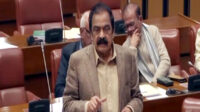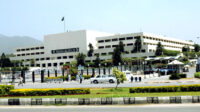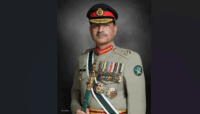There was a hot discussion on the Presidential form of Government; the top trend on the social app – Twitter was: ملککیبقاصدارتی_نظام#. The Prime Minister is also interested and got a wonderful public response on this form of government.
The 8th amendment of Pakistan’s Constitution 1973 gave the powers to the President and then with the enforcing of the 13th amendment, Pakistan’s system of government was shifted from a Semi-Presidential system to the Parliamentary Democratic Republic system. The 17th amendment again assigned the powers to the President and the 18th amendment, the latest amendment, declared the paramount authorities, powers, and functions of Parliament.
It is observed that many people just raise the slogan of any governmental form: Presidential or Parliamentary but, unfortunately, they don’t have knowledge regarding forms of governments. That’s why I’m sharing the merits of the “Presidential” and demerits of the “Parliamentary” system:
Air Mauritius A350s Avoid Mid-Air Collision Over Sudan
For more such Opinions, click here!
1. STABLE GOVERNMENT
The term of the chief executive is fixed in a presidential form as he can’t be removed from his office prior to the termination of his term, except through impeachment [Quasi-Judicial process]. Stability in government enables the president to initiate long-term planning and concentrate his full attention on administrative affairs.
In contrast to this, the life of a cabinet under a cabinet form of government is dependent on the support of the parliament. In countries having a multi-party system, the governments are comparatively weak and unstable due to coalition governments. Such government can neither chalk out a sound administrative policy nor can give a good administrative performance. Moreover, there is inconsistency and discontinuity in policies due to political instability.
2. SEPARATION OF POWERS
There is comparatively less probability regarding the emergence of autocracy trends under presidential form as there is a division of legislative and administrative powers between two different departments. The executive isn’t overburdened due to the absence of legislative business and can concentrate on administrative affairs. The legislature, on the other hand, can concentrate on legislation. As the fate of government isn’t involved in the passing of bills, the parliamentarians can do legislation over and above all expediencies and political considerations in the best interest of the nation.
In a parliamentary form of government, the cabinet may assume the role of a dictator as it can control legislation effectively. Most of the bills which are later transformed into LAWs are government bills. Thus, the real function of the legislature becomes confined to providing majority support to its cabinet and practically it is reduced to the position of a ratifying chamber. As a result, the parliamentarians lose all interest in legislation.
City School Islamabad Holds Model United Nations
3. ACCOUNTABILITY
Administrative responsibility, under a presidential system, can be clearly located in any one person. Whereas in a parliamentary form, the responsibility stands divided between the cabinet and the parliament: as all administrative policies got to be ratified by the parliament. Moreover, within the cabinet, even responsibility can’t be located in any one person. The Prime Minister has to adopt a compromising attitude in administrative matters so as to accommodate the parliamentarians. The situation becomes all the more alarming in the case of a coalition government. Under such a government, the responsibility remains divided among different parties and groups.
4. EFFICIENCY
An important advantage of the presidential system lies in its output. The incharge of the different portfolios can concentrate their attention on administrative matters as they don’t have to waste their time in the legislative process. This results in maximum administrative output. Moreover, the president has a free hand in making administrative policies. He hasn’t to bother in getting the support of the legislative majority or that of his cabinet colleagues.
But a different situation prevails in a parliamentary form where administrative policies generally reflect political expediencies and are based on “Political Bargaining”. For keeping the support of the majority group in parliament; the cabinet remains under constant strain and pressure.
5. CHECKS AND BALANCES
Complete separation of powers between the branches of government, however, is neither possible nor desirable: a system of checks and balances is always entertained. President shares (to some extent) in legislation while legislature also exercises some control over administrative matters.
In America, for example, the president can veto the bills passed by congress and send messages to it for legislative guidance. Constitutionally speaking, he is a legislator in his own right and has an effective say in legislation by virtue of his control over Congress through his party colleagues. Congress, on the other hand, especially the Senate shares in some administrative powers. It can also affect administrative policies by virtue of its control over the purse of the nation.
PCB makes amendments to PSL playing conditions
PM’s advisor Shahzad Akbar resigns from his post
6. POPULAR GOVERNMENT
Under the presidential system, the president is elected directly or indirectly by a popular vote. The indirect method of election for the presidency as envisaged by the framers of the American constitution has become practically direct due to the development of party politics.
But in a parliamentary form of government, the real executive is appointed by the parliament. The electorate elects the members of parliament but they have no direct say in the formation of the cabinet. There is every possibility that the voters consider a particular candidate fit for legislative business but unsuitable for an administrative job. Moreover, the appointment of ministers isn’t always on the basis of merit or popular support but it is based on political expediencies.
7. POLITICAL STABILITY
The presidential form of government is most suitable for those societies where people are divided on an ethnic, racial, or religious basis. The presidential executive can effectively control the administration and develop consensus, at least, on national issues.
But the parliamentary system, due to its peculiar structure is dependent on many pre-conditions. The probabilities of its success are remote in a people who lack political consciousness and have a multi-party system.
The aforesaid merits and demerits would help innocent citizens to perceive the forms of governments in a better way. Contemporary, Pakistan has a mixed form of government and system of administration: Parliamentary form and Federalism system. On the other hand, America has a presidential as well as a federalism system and the UK has a Parliamentary system but they have a unitary form of administration. Pakistanis are showing much more interest in presidential form. Muslims usually argue that this form of government [Presidential] is nearest to the “Khilafat”.
For more such Opinions, click here!
Bismah Maroof back as Pakistan captain for World Cup
PCB mourns passing of Aftab Baloch
What to do if you test Covid-19 positive?
This write-up has been contributed by Chaudhry Ahsan Raza Jutt. He can be contacted on @AhsanRaza_Jutt on Twitter.
Stay tuned to Baaghi TV for more. Download our app for the latest news, updates & interesting content!






